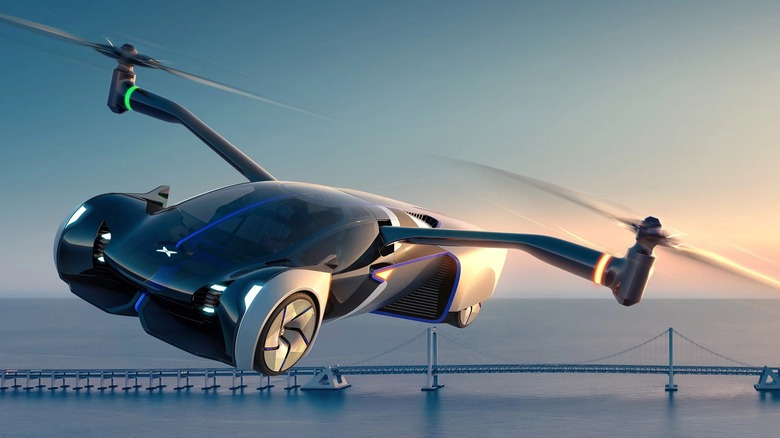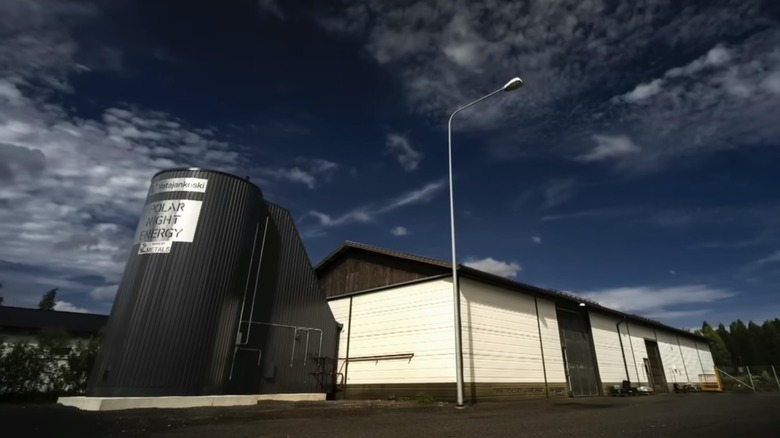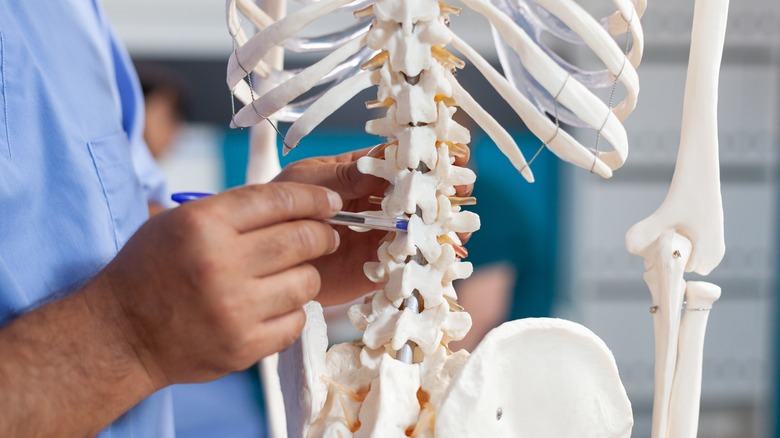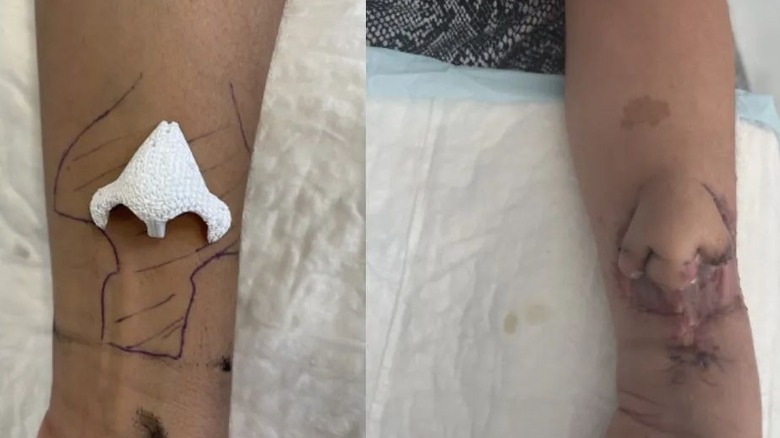Tech That Will Blow You Away In 2023 And Beyond
The idea of 3D-printed meat, implants to fix paralysis or artificially grown body parts were once the realm of science fiction, but recent scientific developments mean that what was once just fantasy is now closer than ever to becoming a reality. New discoveries are being made every month, and 2022 has been an exceptionally exciting year for cutting-edge tech. Many of these new technologies address humanity's most pressing issues, like the climate crisis, energy crisis, or food shortages, but there are some that are just plain cool, too.
Part of the reason there have been so many new developments is that researchers are finding new ways to harness existing technologies, with things like 3D printing and increasingly capable AI being the driving forces behind many of the biggest innovations. It's fair to say that the year has seen plenty of promising studies published that feature technology that could revolutionize many people's everyday lives within the next few years, and here's a small selection of the best.
3D printed steak
Meat alternatives have been steadily growing in popularity over the past few years, with proponents often claiming these alternatives are both healthier for the consumer and better for the environment (via Food Policy Center). One of the most common criticisms leveled at meat substitutes is that they can never truly replicate the experience of eating real meat, since most of them don't quite match up in either texture, flavor, or both. However, that might soon be a thing of the past, as several startups now claim to have made 3D-printed "meat" that's more realistic than ever before.
Israeli company Redefine Meat was one of the earliest to offer 3D-printed steaks, with its first product launched in 2020. In October 2022, the brand announced a distribution partnership with a major meat importer to bring the product to shops all over Europe, including the launch of a new printing factory in the Netherlands. Redefine Meat uses a mix of soy and pea proteins, along with other vegetable-derived ingredients, to print its steaks. But, that's not the only method being developed: another Isreali startup, Steakholder Foods, recently unveiled beef grown from bovine STEM cells (or "starter" cells) in lab conditions. Once grown, Steakholder can use the fat and muscle tissue to print a steak in any configuration, allowing buyers to be able to choose the exact fat percentage and marbling pattern desired.
Antibacterial, stain-proof clothing
Nanotechnology is currently being developed for use in a lot of different fields, from medicine to manufacturing, but one of the most unexpected developments for nanotech comes from the world of fashion. Using nanofiber or nanoparticle coatings, several companies have been developing ways to improve the properties of clothing fabric without compromising on the feel and appearance to the wearer. According to an article published in the Nanomaterials journal, these improvements include coatings that feature hydrophobic molecules, which are capable of repelling all manner of liquids.
In simple cases, this could make it easier to make waterproof clothing, but the technology also shows potential for repelling more complex liquids like wine, coffee, or mustard. If a liquid like wine was unable to sink into the clothing fabric, this would make it essentially resistant to stains, so more accident-prone wearers would no longer have to worry about embarrassing stains on their shirts or trousers. Nanocoatings have also been shown to have antimicrobial properties, which can help stop the growth of bacteria. This could help wearers feel cleaner and smell fresher for longer, and has the potential for use in a clinical setting, too.
AI in medical diagnosis
Artificial intelligence is being used in a variety of ways across the healthcare industry, with the general aim of making access to healthcare easier and more comprehensive than ever. One example of this is IBM's Watson Health, which uses machine learning to absorb vast amounts of information from patient records, case studies, and medical journals. This data is then processed to give researchers insights into trends or patterns that wouldn't have been possible to achieve with human analysis alone.
The technology has been compared to having a doctor that has read every single study, journal, and medical database available, then being able to use it to assist with complex diagnoses or find improvements to current medical practice. Sifting through vast amounts of data to find patterns is one of the key limitations of traditional medical science, but with the power of AI, medical research of this nature is now potentially a lot easier than before.
New EV battery technology
Anyone who's been in the market for a new car in the past few years is well aware that the EV revolution is underway, and most manufacturers now offer at least one electric model in their lineup. One of the biggest barriers preventing further adoption of the technology is the limitations of current battery tech, which is heavy and bulky and requires a much longer refueling time than an equivalent gas-powered car. Research is currently ongoing to optimize the design of EV batteries so that almost every part of the pack is made of active material, that is, that it can hold a charge. The placement of the batteries within the car is also a key focus for researchers, with more efficient battery placement leading to potentially significant real-world range gains.
While redesigning the packaging of EV batteries will help a car's range, it won't change the long recharge times that EVs currently require. However, researchers at Pennsylvania State University published a study in October 2022 that could change things dramatically, claiming they have developed a way to fast-charge a car battery in just 10 minutes. This new type of battery also uses cheaper rare earths, which could potentially help bring the cost of EVs down to be more in line with their gas-powered counterparts. For now, the tech is only in the prototype stage, but the team is reportedly working on a way to bring their design to production in the near future.
Quantum internet
Quantum computers use the power of quantum bits (or qubits) to work significantly faster than a traditional computer can, enabling them to solve highly complex problems at record speeds. While building a quantum computer is no longer the realm of science fiction, researchers have, until recently, been unable to chain them together in any meaningful way. However, in February 2022, a team at Caltech published a case study where they had used qubits made from an ion of ytterbium, a rare earth element, to create a prototype quantum network.
The technology is still in its early stages, but the research team's vision is to eventually be able to create a "quantum internet" that can match the speeds of quantum computers, enabling machines to be chained together and hence increasing their computing power even further. The Caltech study also suggests that the tech could one day be used to create "unbreakably secure communications using quantum cryptography," although it's unlikely to be developed into anything viable outside of lab conditions for the foreseeable future.
Batteries made of sand
Reducing global reliance on fossil fuels is one of the biggest steps in addressing climate change, but switching to renewable sources of power is not without its problems. One of the biggest issues is that renewable power tends to be inconsistent. For example, solar panels can only generate electricity when the sun is shining, and in many parts of the world, winter sees a drastic reduction in average sunlight hours. A group of Finnish engineers recently proposed a solution –- a sand battery that can store heat effectively for very long periods of time (via BBC).
Using green energy bought from the grid when the supply is high, a resistance heater heats the sand to over 600C, which can remain at that temperature for months. The battery uses low-quality sand that has been rejected by construction suppliers, and a fan to direct hot air to district heating pipes. It's much simpler in design than a traditional lithium-ion battery, and as a result, it's much cheaper to build. The company behind the technology, Polar Night Energy, claims an 8MWh battery made of sand costs $200,000, while an equivalent lithium-ion battery would cost $1,600,000. At the moment, the battery is most useful for storing heat over long periods, so its usefulness is limited to places where a district heating system is already in place. However, the company is also working on a way to convert that stored heat back into electricity to power the grid.
Reversing spinal cord injuries
Spinal cord injuries often have a huge impact on a victim's life, with paralysis a common result of damaging the vital nerves that control the lower half of the body. In Switzerland, three people who had been paralyzed from such injuries were able to walk independently again thanks to a breakthrough new technology developed by a team of neuroscientists. The study, published in the Nature journal, describes how the researchers implanted electrodes that mimic the electrical signals the brain sends to body parts.
These implants are connected to AI software, which reproduces the signals that subjects need to stand and walk. El Pais reports that initially, the patients were only able to walk with the use of a harness, but after a few months of training, one patient was able to walk independently and stand drinking at a bar. Although the initial trial was successful, the technology is only in its early stages and the researchers are planning to conduct more clinical trials through 2023. If those, too, are successful, the team plans to make the tech commercially available a few years after.
Bioprinting body parts
After losing her nose to cancer in 2013 and undergoing several failed nasal reconstruction surgeries, a French woman recently became the first person to grow a new nose — on her arm. The pioneering operation saw a 3D-printed nose structure implanted onto the patient's forearm, which then grew skin and was eventually transplanted back onto her face. 3D Printing Industry reports that the structure to grow the new nose was made by bone graft specialist CERHUM, using a bio-compatible bioceramic in which the porosity of the structure can be adjusted.
This allowed the team to develop a 3D-printed structure that was as similar as possible to the patient's missing nose shape and structure, which gave it the best chance of being accepted and recolonized by the body. After successfully growing the nose on her arm and undergoing the transplant process, the patient is reportedly "doing very well," although has had to undergo hospitalization and a course of antibiotics after the procedure. The operation was the first of its kind, but since it was successful, it paves the way for more bioprinted body parts to be made in the future.
Flying autonomous taxis
The idea of flying cars has been around for a while now, so it's natural to treat any developments in the segment with a healthy dose of skepticism. But, Chinese carmaker XPeng recently showed off its first flying car at an event in Dubai, with the aim of putting it into production within a few years. Called the X2, the car is made of carbon fiber to keep weight to a minimum and can carry two passengers up to 21 miles on one charge. In an interview with Euronews, a representative for the company said the idea wasn't as pioneering as it seemed. He said, "we transport people – and also cargo – from A to B [...] we have been doing this for years, and it's called the helicopter."
The X2 is equipped with AI that allows it to drive itself between destinations, so no user input is required. A senior official at the UAE's Civil Aviation Authority claimed that the country is ready to adopt this new mode of transport, with initial consultations underway to add launchpads to the latest luxury developments in anticipation of XPeng's car reaching production. He stressed, however, that this was "conditional upon the success of the certification," with safety concerns needing to be addressed before the flying cars will be authorized for public use. If all goes well, he claimed that the first commercial vehicles might be launched as soon as 2025.
Nuclear fusion energy
Nuclear fusion has the potential to become a virtually unlimited source of energy, and research has been ongoing since the 1950s to develop it. Although it's still a long way from being commercially viable, The Washington Post recently reported that a breakthrough had been made. For the first time ever, scientists recorded a reaction that produced more energy than it required, albeit in strictly controlled lab conditions. Although the story was leaked by WaPo, the results of the study aren't public at the time of writing, so the details surrounding the breakthrough are still unclear.
The research was conducted by the U.S. Department of Energy and if it could be replicated at a large scale, it could be the key to solving the energy crisis that's currently affecting billions around the world. That is, however, a very big if – at present, billions of dollars of specially-developed equipment is needed to create a single reaction, and the stresses produced during that reaction were so high, there was reportedly a serious risk of the equipment being destroyed altogether. So, it seems that the days of readily-available nuclear fusion energy are still a long way away, but with enough continued backing, it's possible that fusion power plants could one day become a reality.










